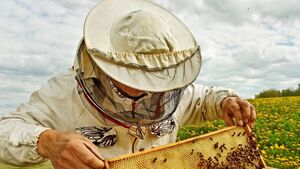Living Greener: Beekeeping is worth the effort

Honey is the most obvious advantage to keeping bees, and the honey can also be made into mead, or honey wine
PEOPLE have worked out relationships with all kinds of animals – cows and other grazers for milk and meat, chickens and other birds for eggs and meat – and we care for them in exchange for a share of what they produce naturally.
We have very few relationships, though, with the vast majority of animals, the insects. Except for silk caterpillars, raised by specialists, there is only one insect that most of us can cultivate – bees.
When people began making beehives, they were usually simple containers like skeps – essentially baskets – which had to be broken and the hive destroyed any time the honey was harvested.
In 1852, a Pennsylvania vicar invented the beehive that is still used today – a wooden box with several frames inside that the bees can use to make honeycombs, without sealing the frames together. Each frame can be pulled out and checked, the bees inspected for disease and progress, and the honey extracted, all with only a brief disruption to the hive.
Bee hives can be kept easily on a small plot of land, and some people keep them in their back gardens or even on rooftops. Most bees will forage for pollen in a radius of several miles, so it doesn’t matter much if a hive is located near homes. All the same, most bee experts recommend keeping the beehive inconspicuous and pointing away from neighbour’s driveways, so the bees’ runway flight is not likely to get in people’s personal space.
Honey is the most obvious advantage to keeping bees, and the honey can also be made into mead, or honey wine. But bees also produce wax that can be used for everything from candles to skin creams – some people chew it like bubblegum.
Also, bees of course, have the natural function of pollinating plants, and most beekeepers say their garden yields increase once they have a hive nearby.
Most beekeepers recommend placing the hive on the north-facing side of a windbreak, open to the southeast sun so the bees get warm as early as possible in the morning.
The hive should be level on dry land, and water should be set nearby so they can get a drink – one beekeeper recommends putting a small bucket of water nearby with a piece of Styrofoam floating on top, so the bees can have a place to stand while they drink.
To get started, you need a few basic materials. Of course, you need a hive, which come in different varieties – but whichever one you get, you should stick with it, as all the frames will only fit that one type.
Next, you need to fill the hive with wooden frames, those rectangular slices of honeycomb that beekeepers remove to get the honey. Most hives come with slides of wax to help get the bees started, and you have to slip the wax into each wooden frame and secure them in place with wire or nails.
You will also need a smoker – basically a cross between a watering can and an accordion — to slow the bees down before you open up their home.
Despite being the smallest animal we’ve domesticated, bees are the only ones we have to sedate before approaching.
The bees will need sugar-water to get them started, before they figure out where all the flowers are in relation to their new home. This is easy to make on the kitchen stove – a kilogram of sugar per litre of water – and most hives, like ours, have a feeder attached.
You don’t need to feed them continually – that would rather take away from the point of getting honey – but it does help them through the early days and again through the winter months.
You also need a bee suit, a one-piece outfit which will seem to consist mostly of zippers. Do try to seal all the zippers completely, or the neighbourhood children will see a strange, white-clad figure flailing and dancing the hokey-pokey out of the forest.
You might feel nervous about starting something like beekeeping, but bees are quite low-maintenance animals, and they are worth it for the pollination and honey. When you first get a hive you might think you’re doing everything wrong, but you'll learn as you go, and most of the time, you'll come out okay in the end.





